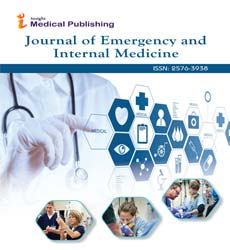ISSN : 2576-3938
Journal of Emergency and Internal Medicine
A Brief Note on Stages of Liver Cirrhosis
Rosen Berg*
Department of Surgery, University of Munchen, Munchen, Germany
- *Corresponding Author:
- Rosen Berg
Department of Surgery,
University of Munchen,
Munchen,
Germany,
E-mail: Rosenberg159@edu.com
Received Date: September 6, 2021; Accepted Date: September 20, 2021; Published Date: September 27, 2021
Citation: Berg R (2021) A Brief Note on Stages of Liver Cirrhosis. J Emerg Intern Med Vol.5 No.5:37.
Description
Liver cirrhosis may be a term wont to describe the histological development of regenerative hepatic nodules surrounded by fibrous bands in response to chronic liver injury. Cirrhosis is a complicated, diffuse stage of liver injury, which is characterized by replacement of the traditional liver parenchyma by collagenous scar (fibrosis). Cirrhosis is amid diffuse distortion of the hepatic vasculature and architecture, leading to vascular disturbance between the portal veins and therefore the hepatic veins, plus porta hepatic fibrosis. The main cirrhosis consequences are hepatic function impairment, increased intrahepatic resistance (portal hypertension), and therefore the development of Hepatoma (HCC).
Types of liver cirrhosis
Laennec's cirrhosis may be a sort of micro-nodular liver cirrhosis that's seen in patients with malnutrition, alcoholism, or chronic liver steatosis.
Posthepatitic cirrhosis may be a micro and macronodular liver cirrhosis commonly seen in patients with hepatitis C virus or uncommonly B virus.
Post necrotic cirrhosis is macro nodular liver cirrhosis which will arise thanks to fulminating hepatitis infection, or thanks to toxic liver injury.
Primary Bailer, Cirrhosis (PBC) Vanishing common bile duct ductepithelial duct canalchannel common bile duct syndrome is an autoimmune disorder of unknown origin characterized by progressive intrahepatic bile duct, nonsuppurative inflammation, andd estruction by T-cell lymphocytes, which leads afterward to micronodular liver cirrhosis, hepatomegaly, with greenish-stain liver on gross examination thanks to bile retention. PBC occurs in middle-aged women in up to 90% of cases. In symptomatic PBC, patients may complain of jaundice within the first 2-3 years, which develops later into malignant hypertension and hepatos-plenomegaly. Within the asymptomatic PBC, the sole symptom is abnormal serum hepatobiliary enzyme.
The liver charactestic any contains few large wets, and lots of small bile ducts. Scarring (Stage III) is characterized by fibrosis and intrahepatic collagen deposition. Hepatic cirrhosis (Stage IV) is characterized by architectural hepatic disruption and accumulation of the bile within the hepatocytes. The disease is diagnosed by liver biopsy, plus detecting ant mitochondrial antibodies (AMA) within the serum. Secondary biliary cirrhosis arises thanks to extra hepatic obstruction of the biliary tree, causing bile stagnation within the liver. This sort are often seen in cases of congenital common bile duct atresia, chronic biliary stones obstruction, or pancreatic head carcinoma. The inflammation within the secondary biliary cirrhosis arises thanks to secondary infection of the bile, resulting in neutrophil acute inflammatory reaction. In con-trast PBC may be a chronic, autoimmune disorder with lymphatic and plasmacyte inflammatory reaction. Cirrhosis thanks to metabolic disease is seen in glyco-gen-storage diseases. tx I -Antitrypsin deficiency dis-ease, hemochromatosis and hepatolenticular degeneration . All the metabolic cirrhoses arc micro nodular except hepatolenticular degeneration (macro nodular). Cirrhosis thanks to circulatory disorders is observed in patients with venous congestion thanks to right-sided coronary failure , venoocclusive disease thanks to herbal medicine, and Budd-Chiari syndrome. In congestive coronary failure , chronic hepatic venous congestion may cause intrahepatic hypertension.
Pathogenesis it's strongly suspected that acute infectious disease may be a hypersensitivity induced by GI-A streptococci. It's proposed that antibody directed against M protein of GrA streptococci cross reacts with normal animal tissue protein present in heart. Joint, brain, skin and other tissue thanks to molecular mimicry • Hypersenstrvity phenomenon is supported by the very fact that-I. Streptococci can't be demonstrated from the location of inflammatory lesion. Symptom typically developer 3-4 weeks after Infectionis.
Open Access Journals
- Aquaculture & Veterinary Science
- Chemistry & Chemical Sciences
- Clinical Sciences
- Engineering
- General Science
- Genetics & Molecular Biology
- Health Care & Nursing
- Immunology & Microbiology
- Materials Science
- Mathematics & Physics
- Medical Sciences
- Neurology & Psychiatry
- Oncology & Cancer Science
- Pharmaceutical Sciences
